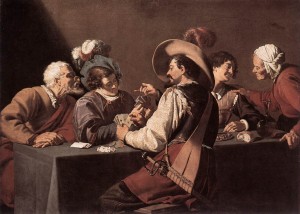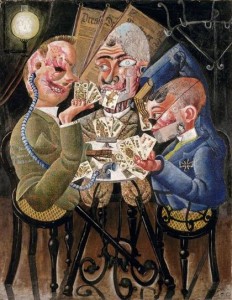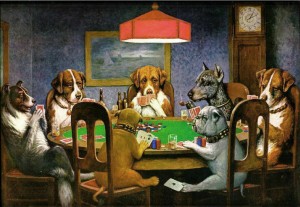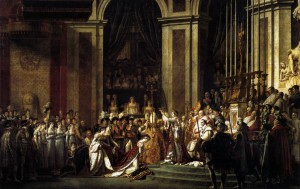Card games have been around for an absurdly long time – hundreds of years at the very least (we have recorded evidence of playing cards originating as early as the 14th century), but some archeologists estimate that we’ve been playing card games for thousands of years, with them originating in China before spreading to India, Persia and Egypt. Whatever the case, it’s quite a safe bet to say that playing cards have been an essential part of human history, and as a result, it’s little wonder that the people using them have gradually found themselves depicted in various works of art for a while. As you can see in the link above, there have been paintings of card players enjoying themselves for almost as long as there have been cards, but today I want to focus on more modern interpretations of the activity within the art medium, and ones that I believe portray it with a unique vision that has something very interesting to say. Because let’s face it – card games have changed a TON since the 14th century. Many gamblers today prefer to play online, on sites like http://www.blackjacksites.info, and as a result these paintings are a bit like little time capsules of days gone by.
”The Card Players” by Théodore Rombouts
 Let’s start off with something from the baroque era – “The Card Players”, painted by Flemish painter Théodore Rombouts. This oil painting is one of my favorites, as I believe it very accurately captures the atmosphere of a traditional card game. Of course, we shouldn’t overlook the fact that, much like many other baroque paintings, “The Card Players” is extremely lifelike and very realistic, but there’s more to its appeal than just the lifelike realism – otherwise, every photograph we took with our phones would be a masterpiece! No, art is all about capturing a moment in time, as well as portraying the emotions and feelings within that moment on the canvas, and I have to say that Rombouts did so spectacularly! With a mere glance, you can see what everyone is thinking, from the focused players to the chatting people to the side. It’s a thing of beauty.
Let’s start off with something from the baroque era – “The Card Players”, painted by Flemish painter Théodore Rombouts. This oil painting is one of my favorites, as I believe it very accurately captures the atmosphere of a traditional card game. Of course, we shouldn’t overlook the fact that, much like many other baroque paintings, “The Card Players” is extremely lifelike and very realistic, but there’s more to its appeal than just the lifelike realism – otherwise, every photograph we took with our phones would be a masterpiece! No, art is all about capturing a moment in time, as well as portraying the emotions and feelings within that moment on the canvas, and I have to say that Rombouts did so spectacularly! With a mere glance, you can see what everyone is thinking, from the focused players to the chatting people to the side. It’s a thing of beauty.
”War Veterans Playing Cards” by Wilhelm Heinrich Otto Dix
 Now it’s time for something a bit more surrealistic! This painting goes by several names, including “Crippled War Veterans Playing Cards” and “War Veteran Invalids Playing Cards”, but the most common one I found is the one above, which is the one I ended up using. Otto Dix, born in 1891, lived through the horrors of both World Wars, but it was very clear that the first one, and the effects that it had on the people of Berlin, affected him the most. His 1920 painting depicts veterans of various stages of disfigurement enjoying themselves, or perhaps at least finding a little bit of solace, by playing cards. Their injuries are vastly exaggerated – all three share only one leg and one arm, they have an assortment of scars and prostheses… They have replaced parts of themselves with artificial constructs, perhaps indicating that war has taken away not only parts of their bodies, but parts of their souls as well – parts that, try as they might (be it through prostheses or card games) they’re never going to be able to take back.
Now it’s time for something a bit more surrealistic! This painting goes by several names, including “Crippled War Veterans Playing Cards” and “War Veteran Invalids Playing Cards”, but the most common one I found is the one above, which is the one I ended up using. Otto Dix, born in 1891, lived through the horrors of both World Wars, but it was very clear that the first one, and the effects that it had on the people of Berlin, affected him the most. His 1920 painting depicts veterans of various stages of disfigurement enjoying themselves, or perhaps at least finding a little bit of solace, by playing cards. Their injuries are vastly exaggerated – all three share only one leg and one arm, they have an assortment of scars and prostheses… They have replaced parts of themselves with artificial constructs, perhaps indicating that war has taken away not only parts of their bodies, but parts of their souls as well – parts that, try as they might (be it through prostheses or card games) they’re never going to be able to take back.
”A Friend in Need”, by Cassius Marcellus Coolidge
 There’s… Really not much to say about this one. The most famous painting in Cassius Coolidge’s “Dogs Playing Poker” series, “A Friend in Need” is instantly the first thing that pops into most people’s head when they’re asked about card games in paintings. Hell, I’m sure you thought about it when you saw the very title of this article, didn’t you? For that very reason, I’m going to keep this entry short – you’ve seen this painting everywhere, you’ve heard everyone talking about, and I doubt I can really say anything new. It’s “Dogs Playing Poker”, and it’s a classic.
There’s… Really not much to say about this one. The most famous painting in Cassius Coolidge’s “Dogs Playing Poker” series, “A Friend in Need” is instantly the first thing that pops into most people’s head when they’re asked about card games in paintings. Hell, I’m sure you thought about it when you saw the very title of this article, didn’t you? For that very reason, I’m going to keep this entry short – you’ve seen this painting everywhere, you’ve heard everyone talking about, and I doubt I can really say anything new. It’s “Dogs Playing Poker”, and it’s a classic.

 While this painting may be very familiar to art students everywhere, you barely see it mentioned in popular culture, which is an absolute shame considering just how spectacular it is. The wreck of the ship “Medusa” is one of the biggest disasters to have ever happened at sea, second only to the Titanic – when an incompetent captain directed his ship into a storm on its very first night, only a handful of people managed to survive on a single raft. The survivors quickly had to turn to cannibalism in order to last, and when rescue arrived thirteen days later, only fifteen men were left.
While this painting may be very familiar to art students everywhere, you barely see it mentioned in popular culture, which is an absolute shame considering just how spectacular it is. The wreck of the ship “Medusa” is one of the biggest disasters to have ever happened at sea, second only to the Titanic – when an incompetent captain directed his ship into a storm on its very first night, only a handful of people managed to survive on a single raft. The survivors quickly had to turn to cannibalism in order to last, and when rescue arrived thirteen days later, only fifteen men were left.  To say that Napoleon Bonaparte is one of the most controversial figures of history would be a massive understatement. He brought a lot of good things to the world (you know how the Western world runs mostly on democracy right now? You can thank Napoleon for that), but he also brought a lot of bad things to it. Some historians think the bad outweigh the good, others disagree, but whatever the case may be, there’s absolutely no dispute that the representation of his coronation, depicted by Jacques-Louis David, is truly among the greatest pieces of art in the world. First of all, the painting is absolutely HUGE – it’s 6 by 10 meters, putting even “Raft of the Medusa” to shame! It also features dozens upon dozens of characters attending the coronation, seventeen of which can be very clearly identified as historical figures which were truly present during the actual event. It’s honestly shocking that it took less than two years to complete this massive work of art, from the time it was commissioned to its finishing touches, which only further speaks of the artist’s talent. Regardless of how you feel about Napoleon, make sure you don’t ignore this masterpiece the next time you visit the Louvre!
To say that Napoleon Bonaparte is one of the most controversial figures of history would be a massive understatement. He brought a lot of good things to the world (you know how the Western world runs mostly on democracy right now? You can thank Napoleon for that), but he also brought a lot of bad things to it. Some historians think the bad outweigh the good, others disagree, but whatever the case may be, there’s absolutely no dispute that the representation of his coronation, depicted by Jacques-Louis David, is truly among the greatest pieces of art in the world. First of all, the painting is absolutely HUGE – it’s 6 by 10 meters, putting even “Raft of the Medusa” to shame! It also features dozens upon dozens of characters attending the coronation, seventeen of which can be very clearly identified as historical figures which were truly present during the actual event. It’s honestly shocking that it took less than two years to complete this massive work of art, from the time it was commissioned to its finishing touches, which only further speaks of the artist’s talent. Regardless of how you feel about Napoleon, make sure you don’t ignore this masterpiece the next time you visit the Louvre!